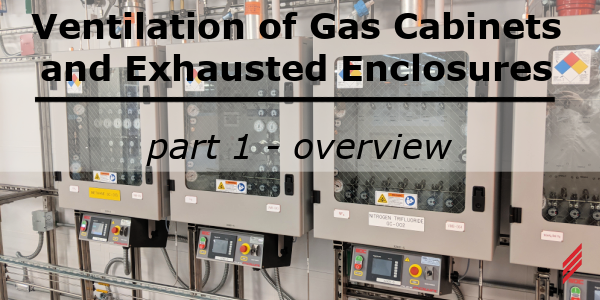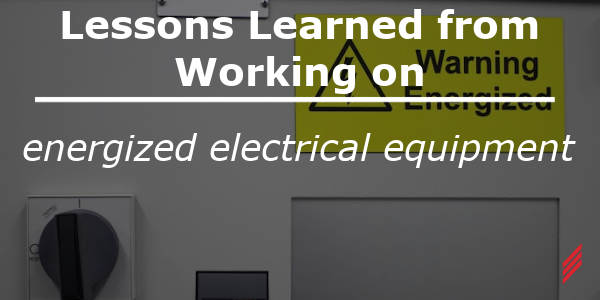Ventilation of Gas Cabinets and Exhausted Enclosures, Part 1 Overview
by William Neuburger on Jan 14, 2021 10:30:00 AM

Gas cabinets and exhausted enclosures are found in many of our client’s facilities, primarily in semiconductor fabrication and research laboratories. The appropriate amount of airflow is not always obvious to the designer. This blog is the first in a series of three that will focus on code requirements and ventilation rates for gas cabinets and exhausted enclosures associated with compressed gases and their distribution.
Part 1: Ventilation of Gas Cabinets and Exhausted Enclosures – Part 1 - Overview
Part 2: Ventilation of Gas Cabinets and Exhausted Enclosures – Part 2 - Gas Cabinets
What is a Hazardous Material?
In general, hazardous materials include:
- Flammable gases (hydrogen, acetylene)
- Combustible and flammable liquids (acetone, ethanol, coffee flavorings)
- Toxic and highly toxic materials as solid, liquid or gas (germane, ozone)
- Pyrophoric materials, gases and liquids most common (silane, trimethylgallium)
- Oxidizing gases and oxidizing liquids (oxygen, nitrous oxide)
Where Do You Encounter Gas Cabinets and Exhausted Enclosures?
- When storing or using hazardous materials and gases and liquids
- Semiconductor fabrication facilities
- Semiconductor research facilities
- Photonics Laboratories
- Nanotechnology Laboratories
- Chemical Plants
What are Statutory Requirements?
- Statutory requirements are essentially law. Each state (sometimes a municipality) defines the codes and standards which carry the weight of law.
- Most states or municipalities adopt and amend codes and standards from NFPA and ICC (some still have their own codes). For example:
- The Vermont Statutes Annotated (VSA) require the Department of Public Safety to publish the Vermont Building and Fire Safety Code, which adopts and amends various ICC and FPA codes.
- The Code of Massachusetts Regulations (CMR) define and amend their combination of ICC codes (Building, Energy), NFPA codes (Fire, Electrical) and self-authorship (Plumbing).
- New York State adopts and amends the ICC codes and publishes them as New York specific codes.
- There are non-statutory guides that we can consider for ventilation or other equipment (not covered in this blog):
- SEMI S6-0707E EHS Guideline for Exhausted Ventilation of Semiconductor Manufacturing Equipment
- AIHA Z9.5 Laboratory Ventilation
- ACGIH Industrial Ventilation Handbook
Statutory Codes
Both International Code Council (ICC) and the National Fire Protection Association (NFPA) codes describe hazardous materials in detail, with dissociation into physical and health hazards.
In North America, most jurisdictions have adopted codes from either the ICC or the NFPA. In those places where ICC is the adopted body, the important document for gas cabinets and exhausted enclosures is the International Fire Code. For NFPA areas, the document of interest is the National Fire Code (NFPA-1). Some jurisdictions adopt codes from both bodies (for example, in Vermont where I live, we have many sections of the International Building Code (IBC) and the National Fire Code (NFPA-1). A designer must understand the code regime at the start of the design activity to be sure to reference the proper codes, at least to establish minimum requirements.
With respect to gas cabinets and exhausted enclosures, both code bodies define gas cabinets and exhausted enclosures harmoniously. Both bodies have similar ventilation requirements for the equipment with some differences.
SEMI Standards
SEMI is an electronics industry organization, providing standards for safety and quality in the realm of microelectronics production. Their standards cover the range of semiconductor production and the equipment used to fabricate semiconductor materials. The standards can apply to gas cabinets and certain exhausted enclosures, but they are not statutory. They are generally harmonious with the statutory requirements, but really apply to equipment manufacturers and not system installers. The two standards that can be useful on a semiconductor project are:
- SEMI S2-0818 Environmental, Health, and Safety Guideline for Semiconductor Manufacturing Equipment
- SEMI F14-93 Guide for the Design of Gas Source Equipment Enclosures
Part 2 of this blog series will cover ventilation requirements for gas cabinets, for both ICC and NFPA code adoption. It will detail the requirements under each code, comparing and contrasting them. The third blog will cover ventilation for exhausted enclosures in a similar fashion, and advice for designers working on gas cabinet and exhausted enclosure installation.
About the Author
Bill has been a mechanical engineer since 1995 and with Hallam-ICS since 2010. His career has brought him to the top of the Transamerica Pyramid Center, chemical plants, underground mines, paper mills, and semiconductor fabrication facilities. He has experience designing, specifying and installing mechanical and electrical systems in the built environment covering industrial, institutional and commercial facilities.
Read My Hallam Story
About Hallam-ICS
Hallam-ICS is an engineering and automation company that designs MEP systems for facilities and plants, engineers control and automation solutions, and ensures safety and regulatory compliance through arc flash studies, commissioning, and validation. Our offices are located in Massachusetts, Connecticut, New York, Vermont and North Carolina and our projects take us world-wide.
You May Also Like
These Related Stories

Lessons Learned from Working on Energized Electrical Equipment

5 Examples of Good Engineering Practice Exceeding Minimum Requirements of Building Codes



No Comments Yet
Let us know what you think